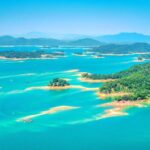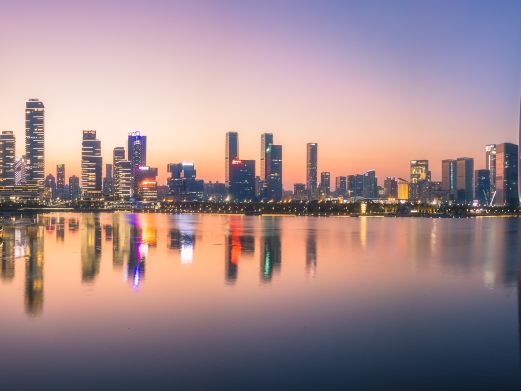Located at the mouth of Shantou Port, Ma Yu Island spans an area of one square kilometer. The island is equipped with seaside bathing areas and accommodations, making it a popular summer retreat for locals due to its clean seawater facing the open sea.
On the island, there are two Tianhou Palaces, built during the Yuan and Qing dynasties respectively, which is why the island is also called Ma Yu. It is also known as ‘Fangji Island’ because in the old days, when ships sailed past, they would release a live chicken at the Tianhou Palace, leading to the island becoming a kingdom of chickens over time.

In 1860, the British established a customs house here, implementing brutal exploitation and using this place as a departure point for the trafficking of laborers. Many people died from torture before even boarding the ships, and numerous laborer skeletons have been unearthed on the island, serving as irrefutable evidence of imperialist aggression against China.
The Xu family, known for their exquisite porcelain inlay art, including the late Xu Meisan and his son, have created masterpieces such as the ‘Double Dragons Fighting for a Treasure,’ ‘Flowers and Birds,’ and ‘Heroes,’ which shine brightly and are considered one of the representative works of contemporary Chaoshan craftsmanship.
The Goddess of the Sea Stone Statue: Located more than 100 meters south of Mazu Palace, facing the sea, the stone statue of the Goddess of the Sea stands as a symbol of the longing for overseas Chinese to connect with their homeland. Designed by the Shantou Arts and Crafts School and meticulously crafted by the Chongwu Fengyuan Stone Factory in Hui’an, Fujian Province, the statue is composed of 108 stone carvings, symbolizing the desire to release 108 peace doves, praying for calm seas in Shantou Port, prosperity for the nation, and world peace.
Donghai Putuo Mountain Temple: Established during the Qianlong period of the Qing Dynasty (1774), the temple is situated next to the southeast wall of the new Mazu Palace. The existing rear wall of the main hall is covered with a shed for the worship of Buddha statues. The government’s religious affairs department has approved the reconstruction, and fundraising is underway. Two significant cultural relic inscriptions have survived: one is the ‘Donghai Putuo Mountain’ temple plaque, inscribed with ‘Respected by Yao Gao of the Right Camp of Nan’ao Town in Guangdong’ and ‘Established in the second month of the thirty-ninth year of Qianlong (1775)’; the other is the ‘Kaisan San Si Zhengrui He Gong Lianwei’ stele, which records that the great monk Zhengrui founded three temples (one of which is Donghai Putuo Mountain Temple), revived five temples, built more than 50 miles of roads, and repaired more than 70 bridges, a testament to his great virtue.
Customs: This is the new customs house of Chaozhou, managed by the Chinese, also known as the ‘Changguan.’ It is located on the two bungalows on Yingzaishan. In 1853, during the Xianfeng era, trade between Chaozhou and Hong Kong surged, and the Guangdong customs established a customs house on Ma Yu, building two bungalows each of 150 square meters (a city cultural protection unit). Since a customs house had already been established in Anbu, the one on Ma Yu was called ‘Chaozhou New Customs.
‘ It was moved to Shantou City in 1863 during the Tongzhi era and taken over by the Chaozhou customs in 1901. Seven years later, a Chaozhou customs house was established on the south side of the island near the sea, managed by foreigners, hence also known as the ‘Foreign Customs.’ A two-story foreign-style building was built for the residence of the foreign head of customs and others (demolished in 2002), and a two-story ocean building was built nearby for customs personnel (commonly known as ‘Yinshui Building,’ demolished in 1991 as it was a dangerous building).Natural Sea Bathing Place: Located on the southeast side, the sea bathing place offers a distant view of Nan’ao Island and a close view of Lu Yu. It is a crescent-shaped bay about 100 meters long. The beach is flat and white, and the seawater is clear and green, making it a perfect place for bathing. The two mountains, Feng and Luan, on either side, are full of strange rocks in various shapes. In the middle of the beach, a small stone peak rises, with cracks resembling petals, hence it is called ‘Peony Peak,’ forming a beautiful scene with the surrounding mountains known as ‘Luanfeng Chao Mudan.
‘ A belt of green trees at the top of the beach provides shade for swimmers. Shower rooms, dining rooms, and restaurants provide various conveniences for swimmers. The sea-eroded shore of the bathing place is inscribed with poems in praise of Mazu by Lai Shaoqi, Zeng Ming’s ‘Qifeng of the Southern Island,’ and Chen Dayu’s ‘Listening to the Waves,’ adding more color to the island.In addition to its natural beauty, Ma Yu Island boasts historical sites and new attractions such as the Shuangzhong Temple, Bo Gong Temple, Friendship Pavilion, Sea-view Pavilion, and the nearby Lu Yu Lighthouse. These sights are abundant and captivating.
Nowadays, transportation to the island is convenient. Visitors can park at the west-side pier under the Bay Bridge and then take a boat ride, which is approximately 1 kilometer away, to reach the island. Ma Yu Island has become a popular destination for tourists in the Chaoshan area. The island is open all year round, accessible 24 hours a day, with specific business hours subject to the daily opening conditions.








